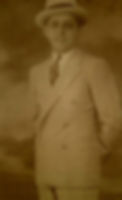The Madman of Chicago: The Life and Violent Times of Sam Giancana
- Daniel Holland
- Jun 19
- 9 min read

It’s often said that Chicago built its empire on the backs of immigrants and the muscle of men willing to do what others wouldn’t dare. Few gangsters epitomised this better than Salvatore “Sam” Giancana, the Chicago mob boss whose career stitched together juvenile delinquency, bootlegging, bribery, CIA intrigue and a brutal death in his own kitchen.
Giancana was born Gilormo Giangana on 24 May 1908, in a gritty Italian enclave of Chicago known locally as The Patch. His parents, Antonio and Antonia, had arrived separately from Castelvetrano, Sicily, hoping to carve out a quiet life in a city already humming with rackets and opportunity. By the time little Gilormo toddled around The Patch’s narrow alleys, the neighbourhood already had its share of bootleggers and bookmakers. When Antonia died in 1910, Sam’s father remarried a local widow, Mary Leonardi, and the extended brood eventually swelled to eight siblings — a cramped, turbulent household that offered few prospects other than the streets.

Cutting His Teeth on Chicago’s Rough Streets
By his teens, Giancana gravitated towards the 42 Gang — a rowdy band of young thieves and hijackers. The name was a cocky twist on Ali Baba and the Forty Thieves; these boys claimed they were two better. In reality, they were small cogs in the larger political machinery of the First Ward, working muscle for old-school ward boss Joseph Esposito. Sam’s skill behind a wheel and a gun made him stand out early. He was known to be an unflappable getaway driver and, more chillingly, a reliable triggerman who could collect debts with a smile and a pistol.
When Esposito was gunned down in 1928 — a murder that whispers often pinned on Giancana himself — the 42 Gang fell neatly into the orbit of the Chicago Outfit, then rising to national infamy under Al Capone’s successors. Arrests came quickly for Sam: first for stealing cars in 1925, then burglary and bootlegging through the late 1920s and 30s. By age 20, he’d dodged conviction for at least three murders and served time at Joliet and Leavenworth.
Climbing the Outfit’s Ladder
By the end of the 1930s, Giancana had secured his place within the Outfit proper. Unlike many roughnecks who fizzled out as expendable foot soldiers, Sam had the nerve and the charm to manage men and grease palms. He aligned himself with Tony Accardo and Paul Ricca, rising stars who would one day become the hidden hand behind Chicago’s criminal machine.
A turning point came in the 1940s, when Giancana masterminded the Outfit’s hostile takeover of Chicago’s Black “policy” rackets, an illegal lottery game that poured millions into the pockets of local kingpins. Local bosses like Eddie Jones and Theodore Roe resisted fiercely. Roe even killed one of Giancana’s made men in self-defence. It sealed his fate: Roe was murdered in 1952, clearing the path for the Outfit to run the lucrative South Side numbers game unchallenged. By the mid-1950s, Sam Giancana was pocketing sums that dwarfed his early stick-up jobs. When Frank Nitti and Ricca eased into semi-retirement, they anointed Sam as the new face of the Outfit in 1957 — but insiders knew the old guard still called the final shots.
The Apalachin Meeting and a “Locked-Up” Chicago
Giancana’s newfound power earned him a seat at the infamous 1957 Apalachin summit, a secret gathering of top Mafia dons at a remote upstate New York farmhouse. When local cops stumbled upon it, dozens of mobsters in slick suits fled into the surrounding woods. Back in Chicago, Sam grumbled that the meeting should have happened in his town instead: “safest place in the world,” he boasted, claiming the Outfit had the police brass and city hall “locked up tight.”

Poison Plots and Presidential Affairs: Giancana’s Brush with Cold War Espionage
If Hollywood screenwriters had tried to invent a more tangled plot, they’d have struggled to match the real-life collision between Sam Giancana’s Chicago rackets and America’s Cold War paranoia. By the late 1950s, Washington’s fear of Communism was so feverish that its spies were prepared to do deals with the very gangsters they spent decades trying to jail. At the centre of this double life stood Giancana, a man who never missed an opportunity to turn dirty work into easy money.
Fidel Castro’s revolution in 1959 threw a spanner in the works for both American businessmen and the Mafia’s Caribbean cash cow. Under Fulgencio Batista, Cuba had been a gangster’s playground: plush casinos, backroom roulette tables, and luxury hotels where Chicago, New York and Tampa crime syndicates skimmed millions under the nose of a corrupt government. Castro shut it down overnight, booted out the mob’s pit bosses and nationalised the casinos. In Miami, gangsters raged about their lost fortunes, and the CIA listened.

Documents now in the public record show just how desperate the agency was. In 1960, CIA middleman Robert Maheu discreetly reached out to Johnny Roselli, a slick mob fixer with deep connections to both Las Vegas and Havana’s pre-revolution gambling scene. Roselli, no fool, roped in two old associates: Santo Trafficante Jr., who once ruled the Tampa-to-Havana corridor, and Giancana, whose influence stretched wherever there were dollars to skim.
The plan sounded simple in a Langley boardroom: get trusted waiters or kitchen staff to slip a poison capsule into Castro’s food or drink. But Havana, post-revolution, was not Chicago’s South Side. Giancana’s nominated inside man, a crooked Cuban official named Juan Orta, lost his nerve after a few clumsy attempts and begged to be let off the job. A replacement scheme involving a Cuban exile leader, Anthony Verona, fizzled too, bogged down in arguments about expense money and covert radio gear.

Through it all, Giancana gleefully milked the operation for cash and prestige. His daughter Antoinette later claimed her father never seriously expected to kill Castro, he just enjoyed the CIA paying Mafia men to dream up gangster solutions to political problems.
Yet if his CIA ties read like pulp fiction, his personal entanglements with the White House turned scandal into legend. Judith Exner, a glamourous socialite with a weakness for powerful men, fell into Giancana’s orbit first. He liked her style and trusted her enough to play courier when needed. Before long, Exner had also charmed John F. Kennedy, then a rising political star whose weakness for beautiful women was an open secret among insiders.
Decades later, Exner swore under oath that she carried sealed notes back and forth, from the president’s people to Sam and back again, discussing everything from political favours to the simmering Castro plots. Whether JFK knew how deep the Mob’s fingers were in the plan is still debated, but one thing is certain: Giancana believed he’d helped nudge Chicago’s crucial union votes toward Kennedy’s razor-thin 1960 victory.
If Sam expected gratitude, he miscalculated spectacularly. No sooner had Kennedy moved into the Oval Office than his brother, Robert F. Kennedy, made busting the Mafia his personal crusade. Giancana, who had once bragged that no politician could touch him, now found federal wiretaps in his clubs and IRS agents crawling through his gambling books. To his dying day, he raged about the “ungrateful Kennedys”, convinced that their betrayal deserved a far bloodier payback than politics could offer.
In the end, this unholy triangle of mobsters, spies, and presidents left a trail of declassified files and unanswerable questions, but for Giancana, it was just proof that in America’s dirtiest business, there were no clean players, only men willing to be more ruthless than the next.

Sam’s Tumultuous Private Life
For a man who thrived on secrets and double-dealing, Giancana’s family life was surprisingly straightforward, at least at first glance. In 1933, at just twenty-five, he married Angeline DeTolve, a soft-spoken young woman whose Basilicata roots matched his Sicilian ones well enough for their old-country families to approve. They set up home in The Island, a working-class pocket of Chicago, before upgrading to a comfortable brick house in Oak Park, a quiet, leafy suburb that seemed a world away from the blood-soaked backrooms where Sam did business.

Together, Sam and Angeline raised three daughters: Antoinette, born in 1935 and destined to write a tell-all book decades later; Bonnie Lou, born in 1938, whom the family affectionately nicknamed La Bonita; and Francine, the youngest, born just as the Second World War ended. By the early 1950s, the family appeared, at least on the surface, to be living the American dream: a handsome father in tailored suits, a devoted mother keeping Sunday dinners on time, and three giggling daughters doing well in Catholic schools.
But the domestic bubble burst abruptly in 1954 when Angeline died unexpectedly. To this day, some accounts suggest complications from a longstanding illness; others hint at stress from knowing too much about her husband’s hidden life. Whatever the cause, her passing turned Giancana’s home into a mausoleum of half-eaten dinners and whispered gossip. His daughters recalled a man who could be playful one moment and terrifyingly silent the next, a father figure overshadowed by the weight of criminal legend.
As the years rolled on, Giancana filled the void Angeline left behind with a string of mistresses, but none turned more heads than Phyllis McGuire. Phyllis was the youngest of the chart-topping McGuire Sisters, a pop trio whose prim stage presence belied a fierce appetite for powerful men. She met Sam at a Las Vegas show, and despite her squeaky-clean public image, the pair carried on a scandalous affair that tabloid editors devoured with glee.

Their favourite hideout was Sinatra’s Cal-Neva Lodge on the shores of Lake Tahoe — a rustic playground where the worlds of Hollywood, the Mob and Washington power brokers blurred into late-night cocktails and whispered favours. It was a reckless arrangement: FBI agents staking out the lodge snapped photos of Giancana and McGuire strolling arm-in-arm by the lake, sometimes even sharing a suite under Sinatra’s nose. The press smelled blood, and when the Bureau leaked evidence of Giancana’s presence on casino grounds, Nevada’s gaming commission pounced. Sinatra, who had invested heavily in the Cal-Neva and the Sands, lost his gambling licences practically overnight — an embarrassment that strained friendships Sinatra could never fully repair. Privately, Sinatra’s tight-knit crew blamed Giancana’s brazen confidence for the scandal that cost Ol’ Blue Eyes millions and painted a target on the Lodge for the feds.
Even years later, McGuire insisted their romance was genuine, not just a gangster’s trophy fling. Yet few in Chicago doubted that Sam relished the power of walking into America’s most glittering showrooms with a chart-topping star draped on his arm. In his mind, it proved what he always believed: no law, no Kennedy, no kingpin could tell Momo Giancana where to sit, what to say, or who to love.
Fall from Grace and a Bloody End
By the time the 1960s were halfway spent, the glitter began to tarnish. Federal prosecutors, egged on by Robert F. Kennedy’s all-out war on the Mafia, hauled Giancana before a grand jury in 1965. Given full immunity, he answered every question with silence — an old-school stand-up act that won him respect behind bars but cost him dearly on the outside. He spent over a year in prison for contempt, reading the newspapers that speculated about his diminishing authority.

While he stewed in a cell, the Outfit moved on without him. Tony Accardo and Paul Ricca — his old mentors — had lost patience with Sam’s high-profile lifestyle. They favoured quiet earners, not flamboyant operators who played footsie with showgirls and the CIA in the same breath. In the shadows, they installed Joseph “Joey Doves” Aiuppa as the new man to keep Chicago’s rackets profitable and its headlines dull.
When Sam emerged blinking in 1966, he saw the writing on the wall. Rather than stick around for fresh subpoenas, he decamped to Cuernavaca, a Mexican hideaway for wealthy Americans dodging various troubles. There, he played the part of an ageing Don in exile: good suits, fancy meals, and local officials bribed to look the other way. For eight years, Giancana convinced himself that the Outfit still needed him, and that the Americans would eventually lose interest.

He was wrong. Mexican police, under pressure from the FBI, dragged him back across the border in 1974. Back in Oak Park, Giancana found his old neighbourhood changed. The feds tailed him relentlessly, neighbours gossiped, and old friends avoided his calls. Worst of all, Congress had him firmly in its sights: the Church Committee was digging into illegal CIA conspiracies, including the rumour that the Mob had been paid to kill foreign leaders. Sam, with his reckless bragging and secret knowledge, was a liability waiting to happen.

On 19 June 1975, that liability was erased. As Giancana stood over his basement stove, frying up his favourite late-night snack of sausage and peppers, a killer crept in unseen. Seven bullets from a .22 pistol found the back of his head and neck. The old boss died exactly as he had lived: talking to no one, trusting few, and leaving a trail of secrets behind him.

Rumours about the hit swirl even now. Some say it was Tony Accardo’s final verdict: a lesson to any wiseguy who confused celebrity for loyalty. Others whisper it was Santo Trafficante, fearful Sam would betray their Cuban dealings to Congress. A darker corner of conspiracy theory insists it was the CIA, tying off a loose end before he could talk too much about poison pills and Havana plots. His daughter Antoinette, who spent decades defending her father’s complicated legacy, once said simply: “My father knew too much.”
Today, in Mount Carmel Cemetery, Sam Giancana lies among the same mob bosses, hitmen and crooked politicians he once outmanoeuvred. His polished marble crypt gives no clue that the man beneath it once played puppet-master to presidents and spies alike — proof that in Chicago, even the loudest lives can end in silence.






















